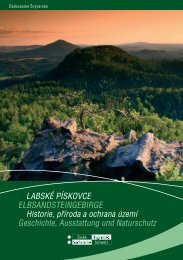ABSTRACT BOOK Sandstone Landscapes ... - Sandstones.org
ABSTRACT BOOK Sandstone Landscapes ... - Sandstones.org
ABSTRACT BOOK Sandstone Landscapes ... - Sandstones.org
You also want an ePaper? Increase the reach of your titles
YUMPU automatically turns print PDFs into web optimized ePapers that Google loves.
TDirk Wessels 1 , Rolf Wessels and Leslie Wessels1 Discipline of Botany, School of Molecular and Life Sciences, University of the North, Private Bag X1106,Sovenga 0727, South Africa (Dirk Wessels: dirkw@unin.unorth.ac.za)An overview of cardinal aspects of South Africa’s sandstone regionsThere are many regions in South Africa where sandstone forms a prominent feature of the landscape andthe presentation will provide an overview of cardinal aspects of select sandstone regions in South Africa.This will be done in order to elucidate possible resemblances between South Africa’s, Europe’s and othersandstone regions of the world. Aspects that will be discussed during the presentation include:Bioweathering and erosion of Clarens sandstone.Endolithic lichen species are the dominant colonisers of sandstone outcrops in many regions of SouthAfrica. These lichens contribute significantly to weathering of the sandstone and soil formation, in additionto natural physical and chemical weathering processes.Significant erosion of the weathered sandstone occurs through an association between insect larvae and theendolithic lichens, in addition to natural erosion processes.Economic importance of sandstone.<strong>Sandstone</strong> was extensively used as construction material in South Africa during the early part of thetwentieth century. These buildings and monuments form part of South Africa’s cultural heritage, withconsequent tourism potential. However, endolithic lichens cause extensive damage to many of these sites.Several National, Provincial and Municipal Parks and private enterprises (game farms and lodges) exploitspecific characteristics of sandstone regions of South Africa for economic gain through tourism.Agricultural activities in sandstone regions.The climate and vegetation of the different sandstone regions have compelled settlers in these regions toadopt distinct farming practices.Ecological importance.<strong>Sandstone</strong>s act as water reservoirs with perceived implications for the vegetation associated with theseregions in South Africa.Such sandstone outcrops are colonised by cryptoendolithic cyanobacterial communities, which representunique micro-ecosystems.The role of sandstone as ecological islands has particularly been neglected as a field of study in SouthAfrica.<strong>Sandstone</strong> regions as cultural and natural heritage repositories.<strong>Sandstone</strong> caves have been used by Stone Age and more recently by the San peoples as settlement areas.The San have left irreplaceable rock paintings, which are nowadays exploited by the tourism industry.Africans on the other hand use some of these caves as ancestral worship and communication sites.As in other parts of the world, sandstone regions in South Africa are well known for their animal and plantfossil records, which are also exploited as tourist attractions.Limited scientific research has been undertaken on many of the aforementioned aspects. Suchshortcomings will be highlighted during the presentation, as it is anticipated that they may provide focuspoints for future collaborative research.




